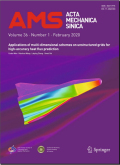- 钛学术文献服务平台 \
- 学术期刊 \
- 基础科学期刊 \
- 力学期刊 \
- 力学学报(英文版)期刊 \
null
Numerical investigation on the flowfield of "swallowtail" cavity for supersonic mixing enhancement
基本信息来源于合作网站,原文需代理用户跳转至来源网站获取
摘要:
A "swallowtail" cavity for the supersonic com-bustor was proposed to serve as an efficient flame holder for scramjets by enhancing the mass exchange between the cavity and the main flow. A numerical study on the "swallow-tail" cavity was conducted by solving the three-dimensional Reynolds-averaged Navier-Stokes equations implemented with a k-e turbulence model in a multi-block mesh. Turbu-lence model and numerical algorithms were validated first, and then test cases were calculated to investigate into the mechanism of cavity flows. Numerical results demonstrated that the certain mass in the supersonic main flow was sucked into the cavity and moved spirally toward the combustor walls. After that, the flow went out of the cavity at its lateral end, and finally was efficiently mixed with the main flow. The comparison between the "swallowtail" cavity and the conventional one showed that the mass exchanged between the cavity and the main flow was enhanced by the lateral flow that was induced due to the pressure gradient inside the cavity and was driven by the three-dimensional vortex ring generated from the "swallowtail" cavity structure.

推荐文章
期刊_丙丁烷TDLAS测量系统的吸收峰自动检测
带间级联激光器
调谐半导体激光吸收光谱
雾剂检漏 中红外吸收峰 洛伦兹光谱线型
不同盐度、温度及光照对漂浮浒苔生理生态的影响
浒苔
盐度
温度
光照
生理生态
期刊_联合空间信息的改进低秩稀疏矩阵分解的高光谱异常目标检测
高光谱图像
异常目标检测 低秩稀疏矩阵分解 稀疏矩阵 残差矩阵
内容分析
关键词云
关键词热度
相关文献总数
(/次)
(/年)
引文网络
引文网络
二级参考文献 (9)
共引文献 (9)
参考文献 (8)
节点文献
引证文献 (0)
同被引文献 (0)
二级引证文献 (0)
1981(1)
- 参考文献(0)
- 二级参考文献(1)
1988(1)
- 参考文献(1)
- 二级参考文献(0)
1994(2)
- 参考文献(0)
- 二级参考文献(2)
1996(2)
- 参考文献(1)
- 二级参考文献(1)
1997(1)
- 参考文献(1)
- 二级参考文献(0)
1998(2)
- 参考文献(0)
- 二级参考文献(2)
1999(2)
- 参考文献(2)
- 二级参考文献(0)
2004(4)
- 参考文献(2)
- 二级参考文献(2)
2005(1)
- 参考文献(0)
- 二级参考文献(1)
2008(1)
- 参考文献(1)
- 二级参考文献(0)
2009(0)
- 参考文献(0)
- 二级参考文献(0)
- 引证文献(0)
- 二级引证文献(0)
引文网络交叉学科
相关学者/机构
期刊影响力
力学学报(英文版)
主办单位:
Chinese
Society
of
theoretical
and
Applied
Mechanics
出版周期:
双月刊
ISSN:
0567-7718
CN:
11-2063/O3
开本:
16开
出版地:
北京中关村15号中科院力学所内
邮发代号:
创刊时间:
1985
语种:
eng
出版文献量(篇)
1876
总下载数(次)
0
期刊文献
相关文献
推荐文献
- 期刊分类
- 期刊(年)
- 期刊(期)
- 期刊推荐
力学
化学
地球物理学
地质学
基础科学综合
大学学报
天文学
天文学、地球科学
数学
气象学
海洋学
物理学
生物学
生物科学
自然地理学和测绘学
自然科学总论
自然科学理论与方法
资源科学
非线性科学与系统科学
力学学报(英文版)2021
力学学报(英文版)2020
力学学报(英文版)2019
力学学报(英文版)2018
力学学报(英文版)2017
力学学报(英文版)2016
力学学报(英文版)2015
力学学报(英文版)2014
力学学报(英文版)2013
力学学报(英文版)2012
力学学报(英文版)2011
力学学报(英文版)2010
力学学报(英文版)2009
力学学报(英文版)2008
力学学报(英文版)2007
力学学报(英文版)2006
力学学报(英文版)2005
力学学报(英文版)2004
力学学报(英文版)2003
力学学报(英文版)2002
力学学报(英文版)2001
力学学报(英文版)2000
力学学报(英文版)2009年第6期
力学学报(英文版)2009年第5期
力学学报(英文版)2009年第4期
力学学报(英文版)2009年第3期
力学学报(英文版)2009年第2期
力学学报(英文版)2009年第1期

 免费查重
免费查重










